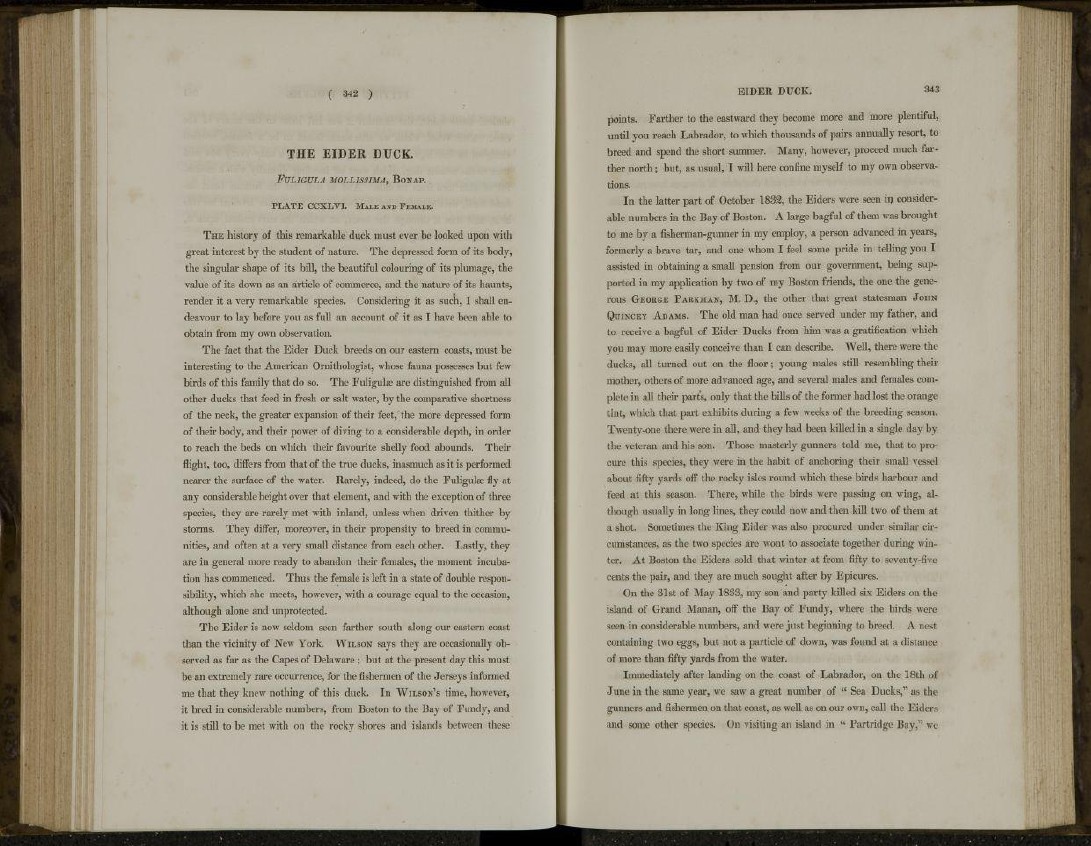
THE EIDER DUCK.
FULIGULA MOLLISSIMA, BoNAP.
PLATE CCXLVI. MALE AND FEMALE.
THE history of this remarkable duck must ever be looked upon with
great interest by the student of nature. The depressed form of its body,
the singular shape of its bill, the beautiful colouring of its plumage, the
value of its down as an article of commerce, and the nature of its haunts,
render it a very remarkable species. Considering it as such, I shall endeavour
to lay before you as full an account of it as I have been able to
obtain from my own observation.
The fact that the Eider Duck breeds on our eastern coasts, must be
interesting to the American Ornithologist, whose fauna possesses but few
birds of this family that do so. The Fuligulae are distinguished from all
other ducks that feed in fresh or salt water, by the comparative shortness
of the neck, the greater expansion of their feet, the more depressed form
of their body, and their power of diving to a considerable depth, in order
to reach the beds on which their favourite shelly food abounds. Their
flight, too, differs from that of the true ducks, inasmuch as it is performed
nearer the surface of the water. Rarely, indeed, do the Fuligulae fly at
any considerable height over that element, and with the exception of three
species, they are rarely met with inland, unless when driven thither by
storms. They differ, moreover, in their propensity to breed in communities,
and often at a very small distance from each other. Lastly, they
are in general more ready to abandon their females, the moment incubation
has commenced. Thus the female is left in a state of double responsibility,
which she meets, however, with a courage equal to the occasion,
although alone and unprotected.
The Eider is now seldom seen farther south along our eastern coast
than the vicinity of New York. WILSON says they are occasionally observed
as far as the Capes of Delaware ; but at the present day this must
be an extremely rare occurrence, for the fishermen of the Jerseys informed
me that they knew nothing of this duck. In WILSON'S time, however,
it bred in considerable numbers, from Boston to the Bay of Fundy, and
it is still to be met with on the rocky shores and islands between these
points. Farther to the eastward they become more and more plentiful,
until you reach Labrador, to which thousands of pairs annually resort, to
breed and spend the short summer. Many, however, proceed much farther
north; but, as usual, I will here confine myself to my own observations.
In the latter part of October 1832, the Eiders were seen irj considerable
numbers in the Bay of Boston. A large bagful of them was brought
to me by a fisherman-gunner in my employ, a person advanced in years,
formerly a brave tar, and one whom I feel some pride in telling you I
assisted in obtaining a small pension from our government, being supported
in my application by two of my Boston friends, the one the generous
GEORGE PARKMAN, M. D., the other that great statesman JOHN
QUINCEY ADAMS. The old man had once served under my father, and
to receive a bagful of Eider Ducks from him was a gratification which
you may more easily conceive than I can describe. Well, there were the
ducks, all turned out on the floor; young males still resembling their
mother, others of more advanced age, and several males and females complete
in all their parts, only that the bills of the former had lost the orange
tint, which that part exhibits during a few weeks of the breeding season.
Twenty-one there were in all, and they had been killed in a single day by
the veteran and his son. Those masterly gunners told me, that to procure
this species, they were in the habit of anchoring their small vessel
about fifty yards off the rocky isles round which these birds harbour and
feed at this season. There, while the birds were passing on wing, although
usually in long lines, they could now and then kill two of them at
a shot. Sometimes the King Eider was also procured under similar circumstances,
as the two species are wont to associate together during winter.
At Boston the Eiders sold that winter at from fifty to seventy-five
cents the pair, and they are much sought after by Epicures.
On the 31st of May 1833, my son and party killed six Eiders on the
island of Grand Manan, off the Bay of Fundy, where the birds were
seen in considerable numbers, and were just beginning to breed. A nest
containing two eggs, but not a particle of down, was found at a distance
of more than fifty yards from the water.
Immediately after landing on the coast of Labrador, on the 18th of
June in the same year, we saw a great number of " Sea Ducks,11 as the
gunners and fishermen on that coast, as well as on our own, call the Eiders
and some other species. On visiting an island in " Partridge Bay,11 we